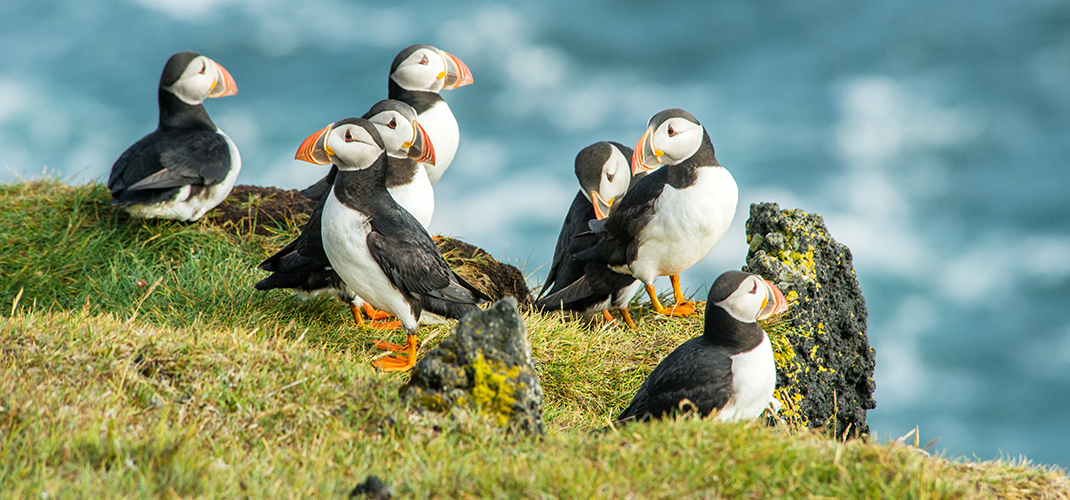Iceland

Iceland is known as the “Land of Fire and Ice” and has a beautiful yet quite extreme contrast geologically. From its active volcanoes to some of the most stunning glaciers and waterfalls Iceland has it all. The country is divided into seven different regions including its vibrant capital of Reykjavík. With weather extremes from its long summer days with 24 hour sunshine to long dark winters where on a clear night you can hopefully take a glimpse of the Northern Lights (Aurora Borealis). The Aurora Borealis actually takes its name from the Roman Goddess of Dawn, Aurora and Boreas, in Greek mythology, the personification of the north wind. The best time to see this phenomenal light show is between September and April.
Reykjavík is a capital known for its natural beauty and culture. The city is the main starting point for touring and cruising and has an amazing café culture by day and restaurant culture at night. There are museums, galleries and many monuments to explore while in the city.
Food is another particular joy when visiting Iceland. It has an abundance of fresh fishing grounds, which make up the staple of the country. Icelandic cuisine is an emerging gastronomic delight full of new creative dishes with a freshness not found anywhere else.
Upon arrival into Keflavíik International Airport in the region of the Reykjanes Peninsula you will first encounter the moon like landscape and natural delights of the country. The region is a geothermal natural wonder filled with lava fields topped with a greenish moss. You will also find the stunning Blue Lagoon just a few minutes away.
The second largest town of Akureyri is found in the North of Iceland. It is located on the Eyjafjörður, one of the longest fjords in the country. Akureyri is a charming town of 9th Century wooden houses, full of charm and colour. The north is also home to one of the world’s best Whale Watching experiences and where you will find the Húsavík Whale Museum, Seal Centre in Hvammstangi as well as the impressive Ásbyrgi Canyon and the Dettifoss Waterfall, the most powerful in Europe. The nearby Lake Mývatn is surrounded by wetlands and has some impressive waterbirds and rock formations. It also offers a tranquil geothermal bathing experience at the Mývatn Nature Baths.
East Iceland has a lot to see and explore. It has the biggest rhyolite formations accessible from any inhabited area around Borgarfjörður Eystri, there are also imposing magma chambers that are filled with colourful mineral deposits that can be visited along the eastern coastline. The coastline is also dotted with many picturesque fishing villages like Seyðisfjörður with its 19th Century setting.
The West of Iceland is home to majestic waterfalls, fjords, glaciers, sleeping volcanoes and craters that all sit complementing each other. Both the Akrafjall and Glymur Waterfalls are less than an hour from Reykjavík. Iceland’s only National Park is also situated in the west, the Snæfellsjökull National Park, with is mystical volcano Snæfellsjökull Glacier, the setting for Jules Verne's 1864 novel “A Journey to the Centre of the Earth”. This has become a very popular area for visitors.
South Iceland is home to some of the country’s most visited sites with brimming natural wonders like spectacular waterfalls and glaciers. The Golden Circle route connects Þingvellir, Gullfoss (a multi-tiered waterfall) and Geysir. Following the coastline you will come across the Skógafoss Waterfall, Jökulsárlón Glacial Lagoon as well as the Vatnajökull Glacier. There are also some spectacular black sand beaches which people are raving about.
The Westfjords are possibly one of Iceland’s better kept secrets with its unspoilt wilderness and beaches including Rauðasandur or Red Beach, which changes in colour. Rauðasandur is situated on Breiðafjörður Bay and they say on a clear day you can see the Snæfellsjökull Glacier across the bay. Hornstrandir is an uninhabited peninsula and nature reserve that is a haven for the Arctic foxes as well as a variety of birdlife. Iceland is often referred to as a birdwatchers paradise where you can see Arctic Tern, eiders, waders, and passerine birds, as well as a variety of seabirds such as the Guillemot, Razorbill, the Atlantic Puffin and Fulmar.
